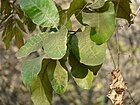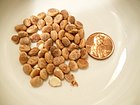Note: This is a project under development. The articles on this wiki are just being initiated and broadly incomplete. You can Help creating new pages.
Buchanania cochinchinensis - Priyala
Priyala is a moderate sized tree. The fruits have a sweet and sour taste and the kernels called chironji have a rich almond like flavour, which are also used in making sweets.
Contents
- 1 Uses
- 2 Parts Used
- 3 Chemical Composition
- 4 Common names
- 5 Properties
- 6 Habit
- 7 Identification
- 8 List of Ayurvedic medicine in which the herb is used
- 9 Where to get the saplings
- 10 Mode of Propagation
- 11 Cultivation Details
- 12 Commonly seen growing in areas
- 13 Photo Gallery
- 14 References
- 15 External Links
Uses
Gastritis, Burning sensation, Fever, Aphrodisiac, Excessive thirst. [1]
Food
The pulp of ripe fruits is eaten. The oily seeds are used in sweet preparations. Roasted seeds are added in milk to enhance taste[2]
Parts Used
Chemical Composition
The oil is a promising source of palmitic and oleic acids. Kernel lipids (65.6%), comprised mainly of neutral lipids (90.4%), consist mostly of triacylglycerol (82.2%), freefatty acids (7.8%) and small amount of diacylglycerols, monoacylglycerols and sterols. [3]
Common names
| Language | Common name |
|---|---|
| Kannada | Murkalu, Kolemaavu |
| Hindi | Char, Charoli, Chironji, |
| Malayalam | Cheru, Kalamavu, Moongapezhu, Mungaperlu, Munnalperu |
| Tamil | Cara paruppu, Kattu-ma, Saraiparuppu |
| Telugu | Chaara, Charumaamidi, Chinna morli, Sarapappu |
| Marathi | NA |
| Gujarathi | NA |
| Punjabi | NA |
| Kashmiri | NA |
| Sanskrit | Kharaskandha, Rajadana, Bahulavalkala, Priyala, Chara |
| English | Cudappah almond |
Properties
Reference: Dravya - Substance, Rasa - Taste, Guna - Qualities, Veerya - Potency, Vipaka - Post-digesion effect, Karma - Pharmacological activity, Prabhava - Therepeutics.
Dravya
Rasa
Madhura (Sweet)
Guna
Snigdha (Oily), Guru (Heavy)
Veerya
Sheeta (cold)
Vipaka
Karma
Pitta, vata
Prabhava
Nutritional components
Priyala contains the Following nutritional components like Kernel lipids, neutral lipids, triacylglycerols; alkaloids; saponins, tannins[2]
Habit
Identification
Leaf
| Kind | Shape | Feature |
|---|---|---|
| Simple | Alternate | Petiole 12-22 mm, stout, glabrous. |
Flower
| Type | Size | Color and composition | Stamen | More information |
|---|---|---|---|---|
| Bisexual | Terminal and axillary panicles | Greenish white | 5 | calyx lobes 5, persistent. |
Fruit
| Type | Size | Mass | Appearance | Seeds | More information |
|---|---|---|---|---|---|
| A drupe | 10-13 x 8 mm | Oblong, laterally compressed, black; stone hard, 2 valved; seed one. | {{{6}}} |
Other features
List of Ayurvedic medicine in which the herb is used
Where to get the saplings
Mode of Propagation
Cultivation Details
Priyala is available through January to May[2].
Season to grow
Soil type
Propagation
Commonly seen growing in areas
Photo Gallery
References
- ↑ Uses
- ↑ 2.0 2.1 2.2 "Forest food for Northern region of Western Ghats" by Dr. Mandar N. Datar and Dr. Anuradha S. Upadhye, Page No.33, Published by Maharashtra Association for the Cultivation of Science (MACS) Agharkar Research Institute, Gopal Ganesh Agarkar Road, Pune
- ↑ Chemical composition
- ↑ Vernacular names
- ↑ BOTANIC DESCRIPTION
External Links
- Ayurvedic Herbs known to be helpful to treat Gastritis
- Ayurvedic Herbs known to be helpful to treat Burning sensation
- Ayurvedic Herbs known to be helpful to treat Fever
- Ayurvedic Herbs known to be helpful to treat Aphrodisiac
- Ayurvedic Herbs known to be helpful to treat Excessive thirst
- Herbs with Fruits used in medicine
- Herbs with Seed kernel used in medicine
- Herbs with Bark used in medicine
- Herbs with common name in Kannada
- Herbs with common name in Hindi
- Herbs with common name in Malayalam
- Herbs with common name in Tamil
- Herbs with common name in Telugu
- Herbs with common name in Sanskrit
- Herbs with common name in English
- Habit - Tree
- Index of Plants which can be propagated by Seeds
- Herbs that are commonly seen in the region of Tropical area
- Herbs
- Deccan
- Tree
- Anacardiaceae






